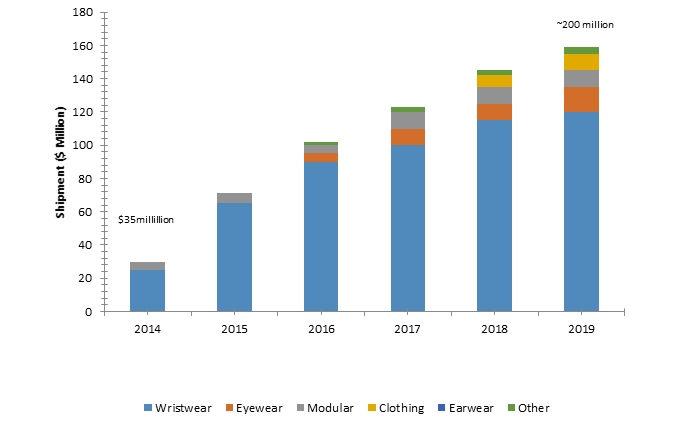The current decade has perceived a greater employability of sensors in nearly every day-to-day product and an entire gamut of services. Sensors that have been integrated into these products have proved to be a key driver of various technological advancements for the next few decades.
On another level, wearable technology today is swiftly appealing to millennials who wish to explore new avenues of innovation with this concept. This is exactly where the emergence of wearable sensors has caught on and revolutionized the application of wearable technology for tracking health and fitness information of the wearer.
Through the seamless facilitation of physiological and biological sensing, these wearable sensors are proving adept at monitoring and diagnosing vital signs, such as heart rate, blood pressure, and other metabolic activities. In addition to this, the disruptive power of the Internet of Things has augmented the demand for wearable sensors in healthcare, fitness, and consumer electronics.
The global wearable sensors market is touted to reach an impressive value of $2,258 million by the year 2022. This would also mean that the demand for wearable sensors and devices is expected to register 18 times increase. According to analysts at Allied Market Research, this growth would be feasible with a projected CAGR (Cumulative Annual Growth Rate) of 52.9% from 2016 to 2022.
Factors propelling market’s immense popularity
The exponential growth of the market is documented by the advent of several driving factors. The increase in the use of smart devices, such as smartphones and tablets which has enhanced the ease of sensing. The rise in the number of big players who wish to invest in novel technologies for the development of smart wearables including wrist wear, smart eyewear, smart rings, and body wear has pushed the stakes higher in the market.
Novelty wearables appeal to customers
Innovation is the buzzword when it comes to the incorporation of smart sensors in wearables. By including sensors in wearables through novel methods, players are taking to the market with all fury.For instance, Apple’s boss, Tim Cook, has been testing a new Apple Watch glucose sensor, which apparently promises to be a game-changer for diabetics.
Another leading provider of wearable technology, Triax Technologies, Inc., has introduced a first-of-its-kind IoT-based wearable belt sensor that could assess worker information and enhance safety, visibility, and efficiency on the construction site. Even Adidas and Panasonic have become prominent names in the wearable sensors scene, with their range of next-generation fitness wrist wears.
Earlier this year, a wearable, wireless sensor that can be used to monitor a person’s skin hydration was developed by researchers from the North Carolina State University. It can potentially be used for applications that need to detect dehydration before it poses a health problem.
Sensor-embedded fabric to take on the market
Amongst all wearable sensors, the segment of bodywear is perhaps the least explored by manufacturers. The greater focus is on creating eye wear, wristwear, and footwear. However, this is set to change very soonas a large number of competitors have realized the untapped potential of the bodywear segment. And this is exactly where the sensor-embedded fabric is expected to take on the market with full vigor.
For instance, Wearable X, after nearly two years of research, has developed yoga pants embedded with electronic sensors. The $299 leggings, embedded with sensors, and activated with a bean-shaped battery clipped behind the wearer’s upper left knee, is meant to help achieve finesse in alignment of yoga postures. Based on the frequency and intensity of vibration, the wearer would know how best to anchor themselves in each yogic pose. Even Bebop Sensors has come up with data gloves embedded with sensors to allow real-time control of games and environment.
The competitive landscape has been very creative and dynamic, in terms of product innovation and launches of novel wearables. The competitors playing in the market are leaving no stone unturned to create products that are efficient, aid in monitoring, and seamless capture of information. The competitors believe that product innovation and superior performance of products in a crucial to gauge its products success in the market.
Geographic synopsis reveals impressive stats
A detailed analysis of the geographical presence of the global wearable sensors market reveals impressive stats. The industry is spread in various regions and countries of the world and certain segments and products are more popular in one than in others. While bodywear and eyewear are some of the fastest growing segments, they have depicted a growth rate of 55% and 54.6% respectively, in the next forecast period. It is the wristwear segment that has yielded the highest revenue in 2015, with a reported $57 million.
North America is poised to dominate the global wearable sensors market in the next few years. This is mostly due to the heavy demand and higher adoption rate of wearable sensors by countries, such as Canada, USA, and Mexico. With the highest revenue-generation of nearly $48 million in 2015, North America is also expected to exhibit a tremendous growth in market size and attain a market value of $864 million by 2022.

The Asia-Pacific and Europe economies are also on the cusp of technological empowerment, and this means a rapid growth for them as well. They form the third and second in the lead. Overall, the global wearable sensor market is poised for a tremendous growth in the next few years. https://www.alliedmarketresearch.com